Click here to go straight to the recipe.
I used to buy broth. I would use half a container, put the rest in the fridge and a couple of weeks later, empty the remains down the drain.
The packaging waste is also excessive.
At Safeway, you can choose from Tetra-Paks or cans for liquid broth; or plastic jars or paper cartons for dried bullion. Tetra-Paks are rarely recycled. Most cans are lined with BPA-infused plastic. And don’t be fooled! Products labelled as BPA-free may pose similar or worse health risks.
Today, I make broth out of what constitutes waste—bones or vegetable scraps. (Go here for my vegetable broth recipe.) I can control its salt content. I can make it without producing waste. In fact, I reduce waste. And it’s healthy. Here’s what Sally Fallon has to say about that:
“Stock contains minerals in a form the body can absorb easily—not just calcium but also magnesium, phosphorus, silicon, sulphur and trace minerals. It contains the broken down material from cartilage and tendons–stuff like chondroitin sulphates and glucosamine, now sold as expensive supplements for arthritis and joint pain.
When broth is cooled, it congeals due to the presence of gelatin. The use of gelatin as a therapeutic agent goes back to the ancient Chinese. Gelatin was probably the first functional food, dating from the invention of the ‘digestor’ by the Frenchman Papin in 1682. Papin’s digestor consisted of an apparatus for cooking bones or meat with steam to extract the gelatin. Just as vitamins occupy the center of the stage in nutritional investigations today, so two hundred years ago gelatin held a position in the forefront of food research. Gelatin was universally acclaimed as a most nutritious foodstuff particularly by the French, who were seeking ways to feed their armies and vast numbers of homeless in Paris and other cities. Although gelatin is not a complete protein, containing only the amino acids arginine and glycine in large amounts, it acts as a protein sparer, helping the poor stretch a few morsels of meat into a complete meal. During the siege of Paris, when vegetables and meat were scarce, a doctor named Guerard put his patients on gelatin bouillon with some added fat and they survived in good health.” — Sally Fallon, “Broth Is Beautiful”
When I buy my chicken and meat, I bring a container to fill and the butchers at the store I patronize no longer appear to think I am insane.
You will need a slow cooker for my version. You could simmer it in a pot on low for about four hours instead, being sure to add more water if necessary as it cooks down.
Ingredients
- Bones
- Water
- Splash of cider vinegar (to draw out the minerals)
- Salt if desired
- Chopped vegetables if desired
Directions

1. Store the bones in containers in the freezer. Before I make my broth, I take them out to thaw. You can probably skip thawing the bones if you store them this way, but the water will heat up slowly with a pile of frozen bones in it, which will consume more energy.
2. If you want to add chopped vegetables, such as onions, carrots and celery, place them in the bottom of the crock. (I made this without vegetables.) Place bones over the vegetables. Cover bones with water by about an inch. Add a splash of vinegar. Replace the lid and turn the slow cooker on to low.
3. Cook for 24 hours.
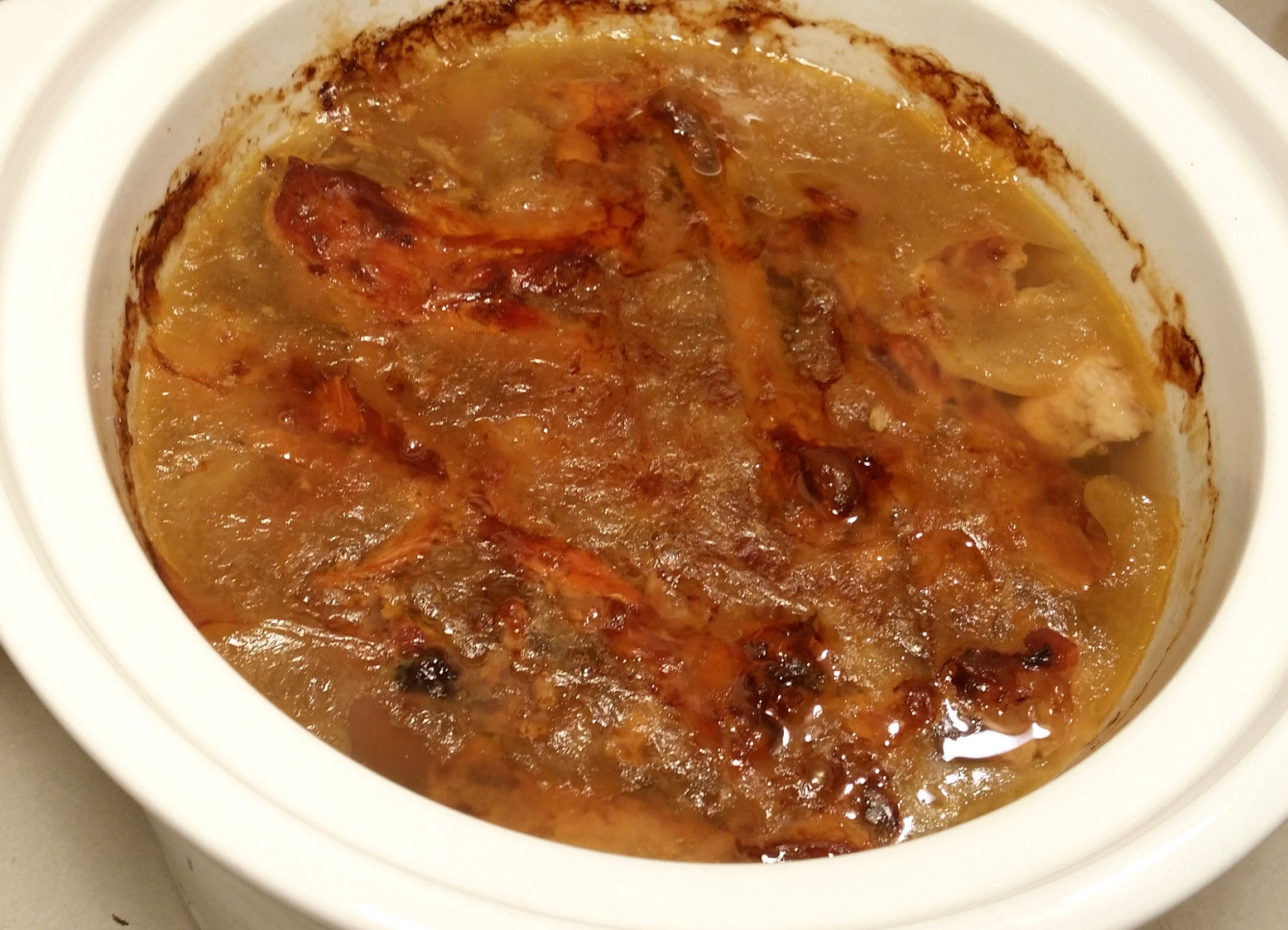
4. Place a colander over a bowl and dump in the crock contents.
5. Strain the broth. I use a funnel with a built-in, removable strainer and I lined it with cheesecloth. (Try not to spill the broth all over the place as I have done here.)
6. Refrigerate. After a few hours, the broth will congeal as in the above pic—a good sign, as it contains all that healthy gelatin. The broth will liquefy when you heat it up. Use within a week.
I have a fairly small slow cooker (4 quarts or so) and this batch yielded about 3 cups, or one jar (on the left). I took a pic of my jar of broth beside a jar of organic pastured pork bone broth from the farmer’s market. The pork bone broth cost $8. I don’t mind paying for quality food in a returnable glass jar, but mine cost $0. Even better!
Bone Broth
Ingredients
- Bones
- Water
- Splash of cider vinegar (to draw out the minerals)
- Salt if desired
- Chopped vegetables if desired
Directions
1. If using frozen bones, remove them from the freezer to thaw.
2. Place chopped vegetables, such as onions, carrots and celery, in the bottom of the crock if desired. Place bones over the vegetables. Cover bones with water by about an inch. Add a splash of vinegar. Replace the lid and turn the slow cooker on to low.
3. Cook for 24 hours.
4. Place a colander over a bowl and dump in the crock contents.
5. Strain the broth.
6. Refrigerate and use within a week.

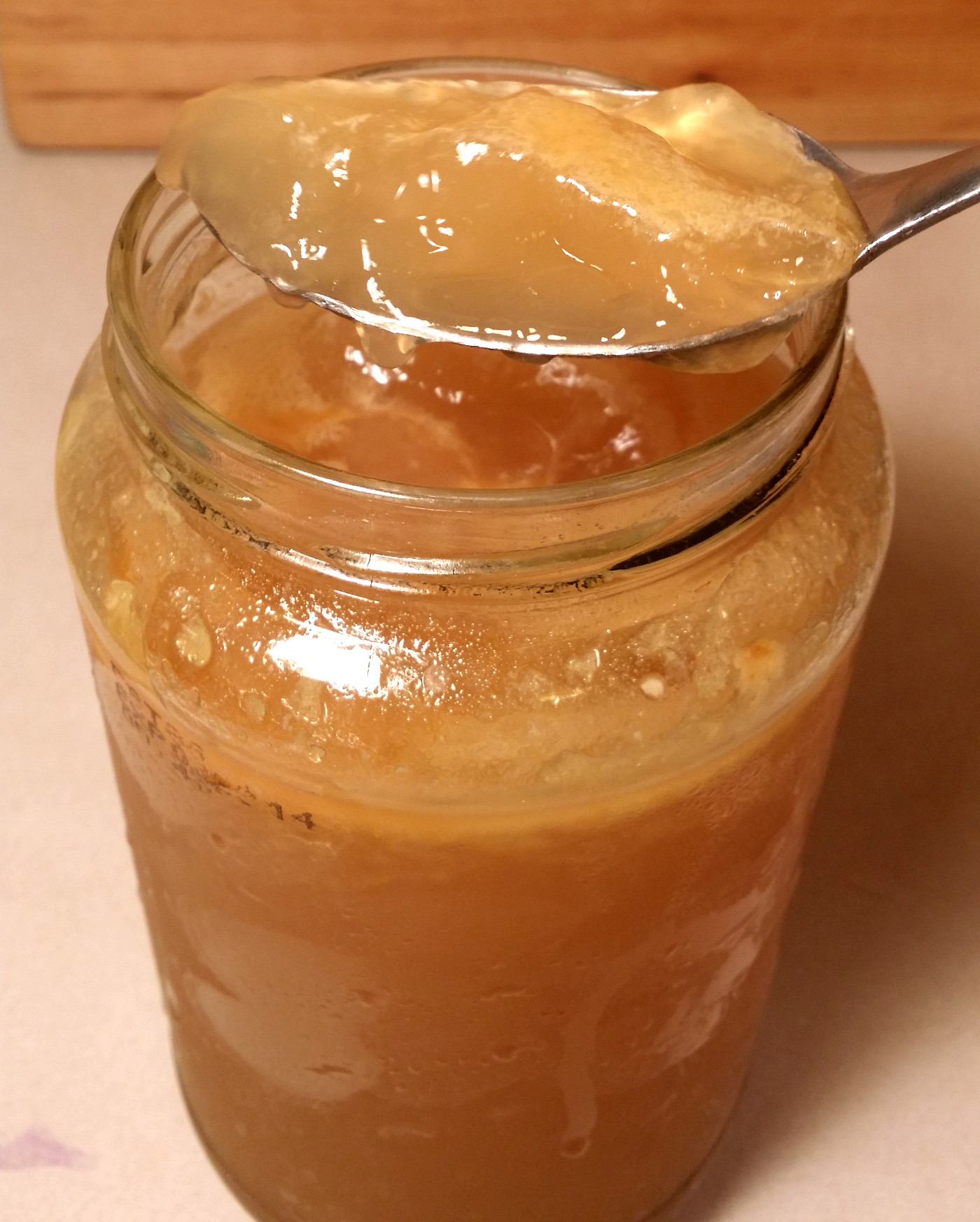
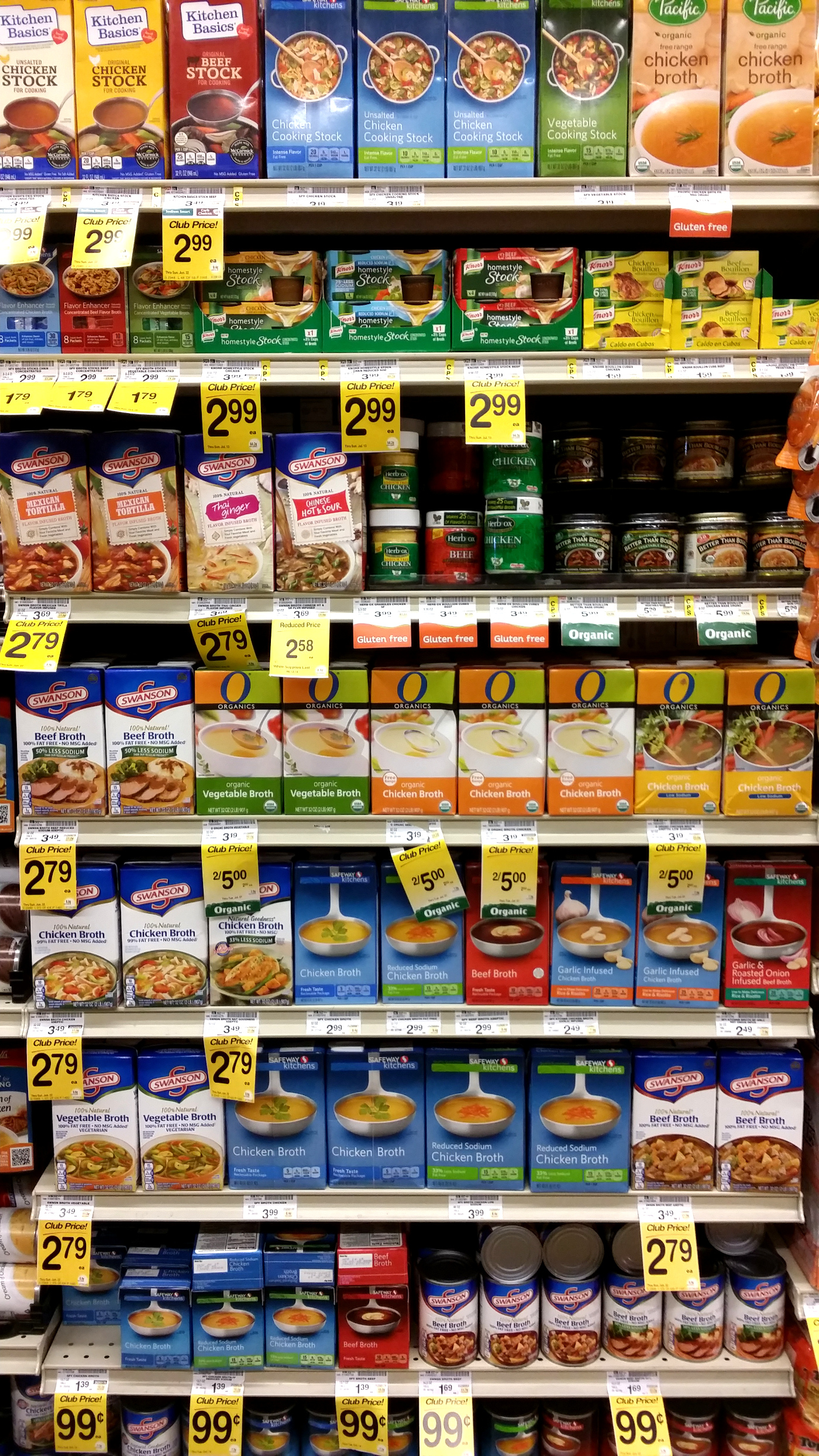


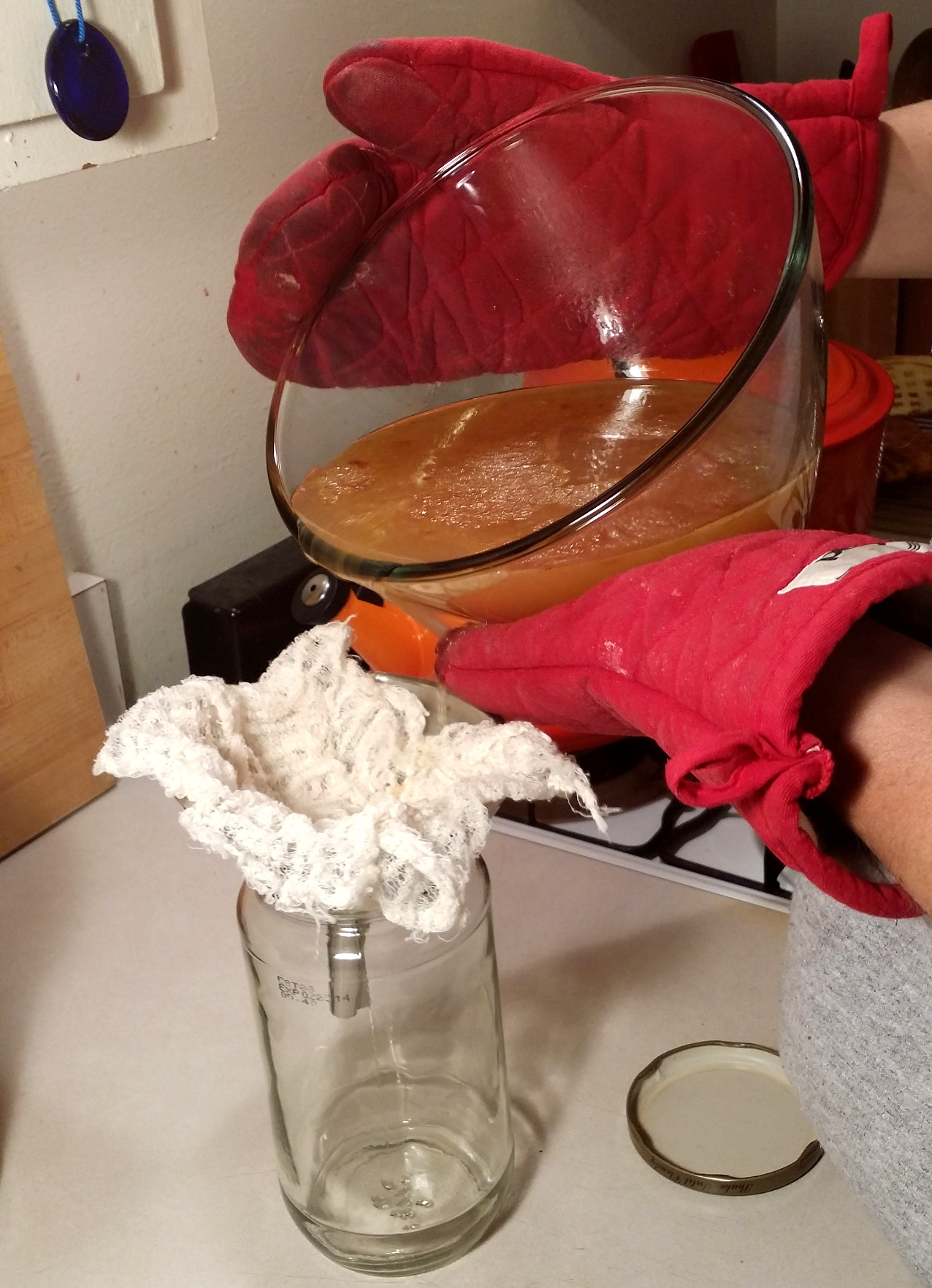

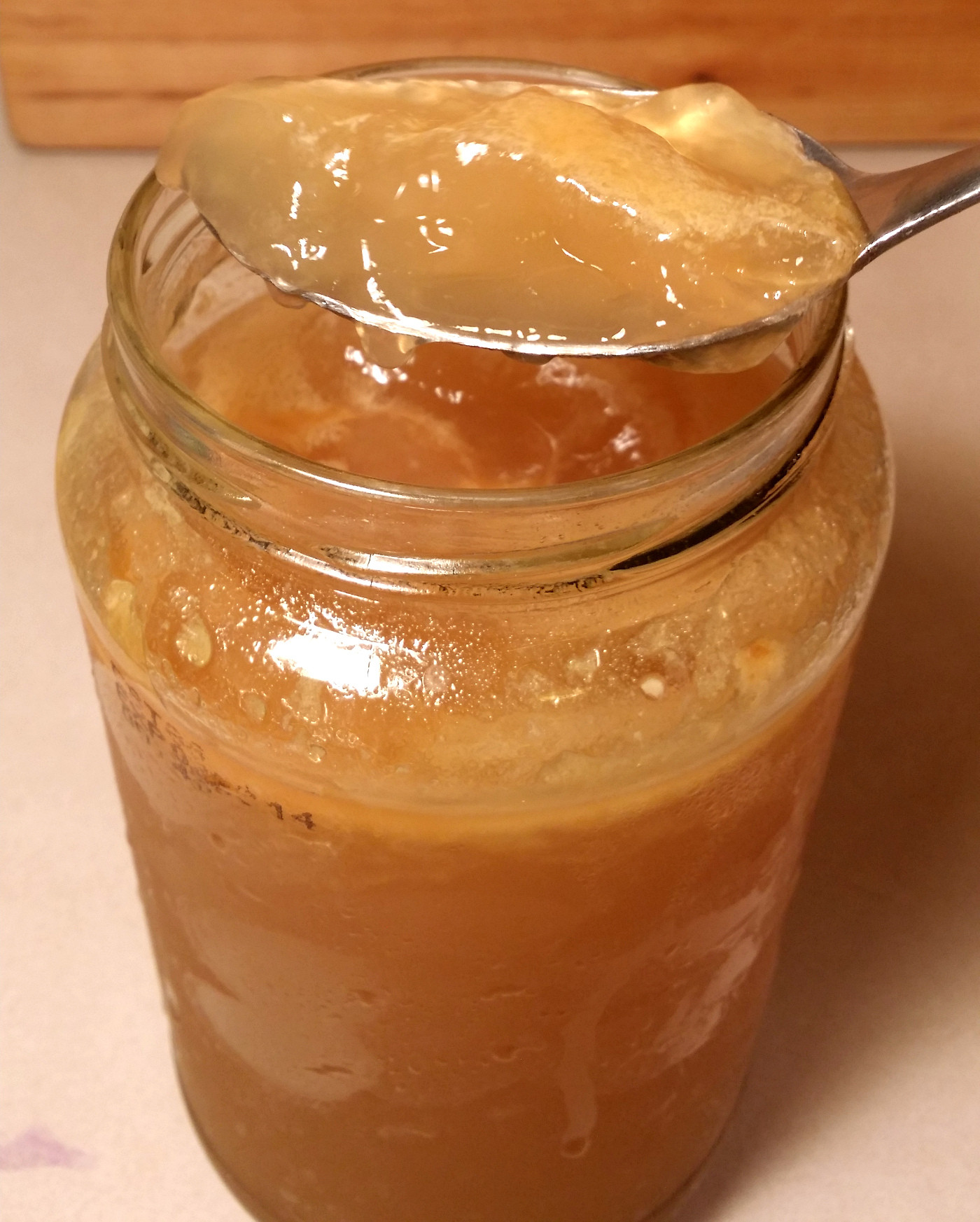

We do the same thing, although I keep the bones frozen so that I can accumulate them until I know I’ll need the broth, then cook it all day before using. I also keep onion skins, carrot tops, mushroom stems, and celery bases along with the bones. Since I’ve been doing this (several years) I’ve tried the processed stuff from the store in a pinch and it ruined my recipe! Not the same product!
Thanks for the sharing this great, simple tip.
Great minds…
Store-bought broth is truly awful. And you don’t know what kind of lives the animals led that go into it. (Well, actually you do know—wretched. I buy pastured meat.) After I started cooking this, I wondered why I ever bought broth. (That goes for other things I make, both food and non-food.) Making broth this way takes less effort than shopping for and buying the commercial version. Thanks for the comment 🙂
Thanks for the recipe. I’m enjoying your blog. I’m going to try and make broth and find a canning recipe so it will be shelf stable. I have canned meats, soups and stews but honestly never thought of canning broth. This will be a good project!
:O
What a fabulous idea! I haven’t thought of canning it either. Will you please let me know how that goes? Thanks for the idea! Happy you’re enjoying the blog 🙂
I’ll let you know. That might be a wintertime project since summer gardening and canning season is getting ready to be in full swing.
Right. You’ll be very busy with that! I’m merely buying the tomatoes I hope to can, and even that seems a bit daunting. You’re actually growing them 🙂
Canning is very rewarding to me. I hope you get the chance to try it some day 🙂
I made chicken broth last month but had to figure out the whole straining thing and not sure I did the best job of it. Thanks for this very detailed breakdown of the steps!!!
You’re welcome! I’m so happy you found them useful. I made a bit of a mess straining it. Next time, I’ll put the jar in the sink before I pour in the broth.
Great idea!!!
Thanks 🙂
I started using my slow cooker to make broth, and have left it as long as three days. It is wonderfully concentrated, so I freeze it in small containers. Your tips and illustrations are very helpful.
Thanks so much for the tips! I just took some more bones out of the freezer to thaw out and try your three-day broth. I’ll freeze some of it this time too! Always great to have a bit on hand, since it does take a while to cook it.
Bone broth is the BEST! I love love our bone broth and I love varying it with different veggies; also, I have a whole book on bone broth recipes. I am so glad you posted here because I didn’t know that such a funnel existed! Also helpful to see that you pour into a bowl first . . . this could help me avoid the major messes I make. My current favorite version calls for spreading a bit of tomato paste on the bones before roasting them, then proceeding. Mmmmmm! May I ask where your community is located? Curious. Thx & have a great weekend!
You have a whole book on broth?! Will you please give me the name? I must check that out! The funnel is great. I think I bought it at Williams Sonoma. I have heard of roasting the bones first and the tomato paste sounds like a delicious edition. How long do you roast them for? The community is in Northern California, in Mountain View. It’s like an oasis in what can be an impersonal, fast-paced, pressure-cooker-like valley. You have a great weekend too 🙂
Great post!
Thank you so much 🙂
[…] Source: Bone Broth […]
I make chicken broth on top of the stove but only cook it for 6 hours. I can’t compare the taste but it looks like your finished product. When I make beef broth, I put the bones on carrots, onions and celery in a roasting pan with a touch of olive oil and roast in the oven for 3 hours. This gives nice browned flavour. Then I add my water to cover and continue cooking in the oven for another two hours. Cool and skim.
Thank you for the pointers. Now I know how to cook it on the stove without worrying about burning down the place. I hadn’t thought of making broth in the oven. I think I’ll try that using my Dutch oven. (I love my Dutch oven.) I’ve discovered so many variations for this recipe and great ideas from these awesome comments 🙂
I’ve made this both in the slow cooker and on the stove, but I’ve never let it cook for 24 hours. I will try cooking it that long next time I use the slow cooker, I’m sure it pulls out more of the good stuff from the chicken!
In our Whole Foods, they don’t even sell organic chicken broth in a can, all they have are tetra packs, which kills me, because I know they’re not getting recycled.
Great! Yes, mine does have a different consistency when it cooks for so long in the slow cooker. Let me know how yours turns out.
I think my Whole Foods is the same—a sea of Tetra Paks and plastic packaging. But they will put my chicken in my container now without asking the manager if it’s okay.
Hello..
I’ve just found your blog today, and i’m hooked!
At first i’m only reading it because i need to make a good broth for my recipe, then ii’m reading almost all of your recipe post!
Thank you for making a lot of great posts (including this one) 😀
Thank you so much for the kind words and for the follow! You’ve made my morning 🙂 I’m following your blog now also. Your recipes look scrumptious!
I use veggie scraps in my broth and I simmer it on the stove top all day long. My stock pots are two quarts larger than my crock pot and I have two of them, so I’ve been known to have two pots going at once. To can it, it needs to be pressure canned. It’s far easier to have jars of nice broth on your pantry shelves than it is to have it frozen, although by time I’ve gotten to the finished product, I will just put it all in the freezer and then pull it out later to can.
Thanks for the tips 🙂
I would love to try to can it. My freezer is small and bursting with frozen fruit right now. By pressure canning, do you mean in Mason jars in a kettle of boiling water (please forgive my ignorance. I’ve canned only a couple of times and don’t know the lingo).
You are referring to hot water bath canning. The hot water bath process is used for higher acid foods – fruits, jams, pickles and tomatoes. Pressure canning uses a pressure cooker – one with a gauge – and is used to preserve lower acid foods. These include all vegetables other than tomatoes as well as meats, broths and soups. The prep process is similar, but I’ve found with a pressure canner, you need to babysit it the entire time, to ensure your pot stays at the proper pressure.
Ah, okay. That’s completely different! Thank you for the clarification 🙂
I have found your blog today and I love it =) I would love to use NO packaging at all but where I live (in the UK) it is just not possible. Near me you cannot buy anything like flour, sugar, pasta (although I mostly make my own) etc without a packet of some sort. I do try, where possible to buy packaging that I can recycle, (either at the local centre or around the home). I am looking forward to trying this stock recipe, I was ill last week and really wanted chicken soup, I felt too ill to go to the store to buy some (which isn’t that great anyway) but I have never made my own as I live alone and only have a bit of chicken at a time. I honestly never thought you could freeze cooked chicken bones, I will be doing that from now on till I have enough to make a stock then I will put it in jam jars (and some in ice cube trays so I can add a small portion to some recipes) I look forward to reading more of your blog and trying some of the recipes =)
Thank you so much! I am very lucky that I can shop the way that I do. We don’t eat that much chicken either, so it can sometimes take a while to accumulate the bones but the freezing really works. And the broth is so good for you and basically free. You can do the same thing with vegetable scraps (ends of carrots, celery, onions, etc). I just freeze them until I have a large pile and then make broth. Good idea to freeze the broth and add a little here and there. I hope you’re feeling better now. The chicken broth should help next time. Thanks for reading my blog. I’m glad you are enjoying it 🙂
Great post! Going to do mine in the slow cooker next time 🙂
Thank you! The slow cooker works really well.
[…] As somebody who likes to view everything as a resource, I love making stocks. There is something visceral about boiling up the bones and scraps after a roast chicken with a few roots and a bay leaf. If you are new to making stocks, check out Anne-Marie Bonneau (aka @Zerowastechef) instructions for a nutritious bone broth! […]
[…] As somebody who likes to view everything as a resource, I love making stocks. There is something visceral about boiling up the bones and scraps after a roast chicken with a few roots and a bay leaf. If you are new to making stocks, check out Anne-Marie Bonneau (aka @Zerowastechef) instructions for a nutritious bone broth! […]
I have a question. Can you or should you mix bone types for this. Beef and chicken in the same batch? Some are raw and some are cooked. Does this matter if it is mixed?
Hmmm, that’s a good question Carol. I have never mixed bone types but I don’t see why you can’t. I think it comes down to a matter of taste. I would say if you try that and you like the flavor, then it works 🙂 I don’t think it matters if some are raw and some are cooked from a safety aspect as you cook this for so long. It will kill anything in the raw meat. I hope that helps.
Years later here and seeing this, thought I would chime in. I have also been following the NomNomPaleo blog, in which Michelle Tam specifically recommends combining different animal types for bone broths (she likes to add pork bones to either beef or chicken). I don’t have a great local source for pastured pork that is reasonably priced, so I haven’t done this, but I would do it in a heartbeat. I usually make just chicken bone broth, but sometimes buy organic pastured veal bones, as they make great gelatin and are available locally for rather cheap (Rossotti Ranch from Point Reyes area). I just haven’t bothered combining it with chicken, as they are both so mild that it doesn’t seem like there would be much of a flavor advantage. Also, raw vs. cooked, I will often do raw chicken backs (frozen actually, from when I cut whole chickens down into pieces for cooking in smaller portions) with the bones that later got cooked up and the flesh around them eaten up. So, effectively, raw chicken backs with cooked leg and breast bones, made into broth, no problem at all.
Thank you so much for all of this information!
Hi and thanks for your wonderful blog! I make bone broth as the base for all my soups (I’ve only done it with chicken bones so far). I throw in all my parsley stems, adding the leaves to the soup. I’ve never added vinegar, though, because I am concerned that no one will eat soup with a vinegar taste! Does the vinegar taste “boil out” by the time it’s finished? Greeks use lemon in their chicken soup, which I imagine does the same thing as the vinegar (but again, I don’t think my kids would eat soup that tasted lemony either). How about tomato? Common base for veg. beef soup anyway.
Thanks for reading my blog Carol 🙂
I add only a little bit of vinegar for some tang. Just a little bit makes a big difference. I think you’re right, lemon would have the same effect. Tomatoes would be good too. I recently made some rescue soup for an event. The main ingredients were black beans and sweet potatoes I needed to use up. I added some of my homemade salsa to it for a bit of tang. People gobbled it up, even kids! A couple of kids asked for seconds!
I recently got a Greek chicken soup recipe in the newspaper. It had lemon juice in it. I tried it and it was good. It doesn’t really taste lemony, just different and fresher.
Just discovered your blog. What a great resource! So, full disclosure please. Had those chicken legs been “gnawed” on at the table? I recently learned about freezing bones but was very unsure if it ok to use bones which had been on family members” plates. I”d love to know what you do. Thanks!
Hi Joana. Thanks for reading blog. I’m glad you found it 🙂 So, I usually cut the meat off the bones for my daughter before she eats. If I don’t, she leaves a lot of meat on the bone and I prefer clean bones for this (and no wasted meat). But I have to admit I’m not very picky about the bones, so some gnawed ones do make it into my broth. That probably sounds disgusting to some but the stuff cooks in piping hot water for hours and hours so that kills anything. Also, I’m usually the only one drinking it. I’m trying to re-enamelize my teeth and have read that bone broth can help. That might be totally woo-woo but drinking broth has so many other benefits even if it doesn’t actually help my teeth.
Thanks, that is what I needed to hear!
Hello Anne Marie, I just have a practical question here. Rather than buying pieces of chicken, I always buy a full chicken at the organic farmer market that I roast in the oven (with olive oil and herbs). After, I remove each part and carefully freeze portion for other days (we are only two, so that lasts for a bit). I make a stock with the rest of the carcass. After if there is still some meat around the bones, I usually finish it with a salad the next day. No Waste! But here is my question: Do you buy full chickens and if you do, which container are you using? I am almost tempted to ask my frames to only remove the feathers so there is no blood everywhere, but it is just such a messy job to remove all the inside that I would much rather have them doing it. Thanks for your answer.
Hi Gabriel. This is a tough one. I haven’t bought a whole chicken (or roasted a whole chicken) in ages 🙁 I would have to bring a large container to the butcher for it and I don’t have one. So if I bought a whole chicken, I would ask the butcher to cut it up for me and that might fit into my large tupperware container (I bought that before going plastic-free). I wish I had a better solution.
[…] Bone Broth recipe […]
what do you do with the bones when you’re truly done with them, after you’ve made stock? I’m under the impression that they came be composted. Thanks so much j!
Hi Julia. I do compost them. Some people will say you should never compost bones but there isn’t much left to these and they break down quickly in my compost pile. ~ Anne Marie
[…] vegetable and fruit scraps are very useful in the kitchen, meat trimmings are equally valuable. Bone broth is delicious and healthy and a great use of chicken, beef, and any other leftover bones. Other […]
Hi- I’m really enjoying your blog- you are my zero waste goal! Could you tell me what you do with your bones AFTER you have used them to make broth? I’ve been putting mine in a Bokashi compostor but I think they take millenia to break down! I dont have a large garden to bury them. I’d appreciate any suggestions. Regards, Lesley Randles Durban, South Africa
Hi Lesley,
Thanks for the kind words. After I make bone broth, I compost the bones. They break down remarkably quickly. After a month or two at the most, I can crush them into powder. I was amazed when I first noticed this. I am not a Bokashi expert but I think it would work in there too.
Best,
Anne Marie
Hi Anne Marie,
I love your blog and your Facebook page – so inspiring!
For a couple of years now, whenever I have had roast chicken, I have turn the bones straight into broth. But I never thought of freezing and collecting them – what a great idea!
And I usually add a bit of dry sherry and a bay leaf to the bones before boiling, but I can’t remember where I read about that. Now I wonder if the sherry does the same job as your vinegar, i.e. help solving the minerals. But anyway, I think it makes the broth taste nice! 🙂
Best wishes from Germany!
Svenja
[…] Note: If you eat meat, you can also make bone broth from leftover bones like turkey bones. Find a recipe here. […]
In my case, making broth this way takes more time and cost. But I was brought up by my mom who try to eliminate anything chemicals in our food and store bought, sucks. I have not splash vinegar as I am afraid that it would be too acidic. Is there a difference in the type of vinegar to use?
Hi …I would like to start a scrap bag to do this…I do have a question though… are the outside covering of carrots and celery and onion and other veggies that have been exposed at the grocery store ( that other people touch). sanitary to use since they have been sprayed with chemicals and touched by people… I know when you peel a carrot it is removed but everyone is using those peels…?…just curious what others feel about this..Even organic is at stores where others handle them..thanks for letting me ask…. I am not a germ freak just wondering if anyone else thought of this……
I recently roasted a whole turkey and then put the bones & skin in a roaster with water in the oven to make broth. I recently purchased a Nesco pressure canner for small batches.(It only does 4 quarts or 5 pints). Then I put the broth into the canning jars with onion, celery, carrots, and canning salt. Turned out so good, I bought another turkey! I had gone to the store to buy chicken breasts to can. Turkey was half the cost! I canned the turkey and use it like I would chicken for chicken salad, etc.
Hi, I made this but mine is nowhere near as pretty as yours. I must have put something wrong in there because there’s a lot of, I don’t know, but it’s almost like sludge. Any idea what I could have done wrong? I used both poultry and beef 0 bones and veggie scraps.
Hello! Maybe it could use more straining. Another thing you can do is refrigerate it. The fat will cool and rise to the top, after which, you can scrape it off. That might help with the appearance. Did you taste it?
Hi, yes it tasted okay. And I was able to scrape off the fat that rose. So I think you’re right, I needed to strain it more. Thanks for your help!